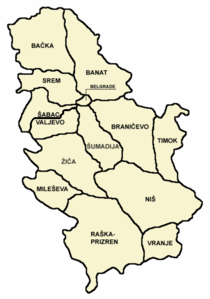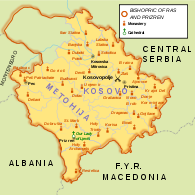
Eparchy of Raška and Prizren
Encyclopedia

Serbian Orthodox Church
The Serbian Orthodox Church is one of the autocephalous Orthodox Christian churches, ranking sixth in order of seniority after Constantinople, Alexandria, Antioch, Jerusalem, and Russia...
, featuring the seat of the Serbian Orthodox Church; the Patriarchate of Peć
Patriarchate of Pec
The Patriarchate of Peć is a Serbian Orthodox monastery located near Peć. The complex of churches is the spiritual seat and mausoleum of the Serbian archbishops and patriarchs....
, as well as Visoki Dečani, which together are part of the UNESCO World Heritage sites of Serbia.
The Eparchy directly serves the Serbian Orthodox of Kosovo
Kosovo
Kosovo is a region in southeastern Europe. Part of the Ottoman Empire for more than five centuries, later the Autonomous Province of Kosovo and Metohija within Serbia...
and the lower Raška District
Raška District
The Raška District expands in the south-western part of Serbia. It has a population of 300,274. Its seat is in the city of Kraljevo.-Municipalities:It encompasses the municipalities of:*Kraljevo*Vrnjačka Banja*Raška...
(Tutin
Tutin
Tutin is a town and municipality in Raška/Sandžak region of Serbia. According to a 2011 census, the municipality of Tutin has a population of 30,770 people. It is the first municipality in Serbia that has renewable wind power.-History:...
and Novi Pazar
Novi Pazar
Novi Pazar is a city and municipality located in southwest Serbia, in the Raška District. According to the official census in 2011, number of inhabitants of municipality is 92,776, while the city itself has a population of 60,638...
).
Early History
The Bishopric of Ras (Raška, Rascia) was established before 879-880.Both the Bishoprics of Ras and Prizren are mentioned in 1019 by Basil II
Basil II
Basil II , known in his time as Basil the Porphyrogenitus and Basil the Young to distinguish him from his ancestor Basil I the Macedonian, was a Byzantine emperor from the Macedonian dynasty who reigned from 10 January 976 to 15 December 1025.The first part of his long reign was dominated...
as separate dioceses part of the autonomous Ochrid Archbishopric.
Bishopric of Ras
Mutimir of SerbiaMutimir of Serbia
Mutimir of Serbia was Prince of the Serbs from ca 850 until 891. He defeated the Bulgar Army, allied himself with the Byzantine Emperor and ruled the First Serbian Principality when the Christianization of the Serbs took place and the Eparchy of Ras was established.He was the eldest son of Knez...
was baptized by missionaries Cyril and Methodius during the rule of Byzantine Emperor Basil I
Basil I
Basil I, called the Macedonian was a Byzantine emperor of probable Armenian descent who reigned from 867 to 886. Born a simple peasant in the Byzantine theme of Macedonia, he rose in the imperial court, and usurped the imperial throne from Emperor Michael III...
(867–886), who sent the priests after Mutimir acknowledged Byzantine suzerainty. The Serbs were fully Christianized by 873 (871), seen in the tradition of theophoric names (e.g. Petar Gojniković, Pavle Branović
Pavle Branović
Pavle Branović or Pavle of Serbia was Prince of the Serbs from 917 to 921. He was put on the throne by the Bulgarian Tsar Symeon I of Bulgaria, who had murdered the previous Prince Petar, who had become a Byzantine ally. Pavle ruled for 4 years, before being defeated by Prince Zaharija, his...
) and the fact that he maintained the communion with the Eastern Church (Constantinople) when Pope John VIII
Pope John VIII
Pope John VIII was pope from December 13, 872 to December 16, 882. He is often considered one of the ablest pontiffs of the ninth century and the last bright spot on the papacy until Leo IX two centuries later....
invited him to recognize the jurisdiction of the bishopric of Sirmium. The Serbs and Bulgarians adopted the Old Slavonic
Old Slavonic
Old Slavonic may refer to:*Old Church Slavonic language*Common Slavonic language...
liturgy instead of the Greek.
Mutimir may have founded the Serbian bishopric of Ras earlier than 871, confirmed by the Fourth Council of Constantinople
Fourth Council of Constantinople
The Fourth Council of Constantinople of 879-880 is believed to have been the Eighth Ecumenical Council by some Eastern Orthodox. Photius had been appointed Patriarch of Constantinople but deposed by a Council of Constantinople called in 869 by Emperor Basil I the Macedonian and Pope Adrian II...
in 879–80.
Byzantine Emperor John I Tzimiskes
John I Tzimiskes
John I Tzimiskes or Tzimisces, was Byzantine Emperor from December 11, 969 to January 10, 976. A brilliant and intuitive general, John's short reign saw the expansion of the empire's borders and the strengthening of Byzantium itself.- Background :...
(969-976) recognized Ras as being the seat of the Serbian lands.
Autocephaly and abolishment
The Serbian Orthodox Church is established in 1219.In 1346, the Bishopric of Prizren is raised to a Metropolitanate.
Modern history
After 1766, the Eparchy of Novo Brdo (Gračanica, historical Hvosno and Lipljan bishoprics) is added to the Eparchy of Prizren.In 1808 the Eparchies of Raška and Prizren are merged into the current Eparchy.
Church of Saint Apostles Peter and Paul
The Church of Peter and Paul served as a seat of the Bishopric of Ras, situated in the capital of Serbia.The present church (7th-9th century) has been built on several earlier churches of which remains have been well preserved. The foundation of the church, the massive columns, ground-plan and the octagonal tower which conceals a inner cupola are examples of the circular mausoleal architectural type used after Emperor Constantine (306-312). Saint Sava
Saint Sava
Saint Sava was a Serbian Prince and Orthodox monk, the first Archbishop of the autocephalous Serbian Church, the founder of Serbian law and literature, and a diplomat. Sava was born Rastko Nemanjić , the youngest son of Serbian Grand Župan Stefan Nemanja , and ruled the appanage of Hum briefly in...
(1175–1235), a Serbian prince, brother of the Serbian king Stefan Prvovenčani and the founder of the Serbian Orthodox Church was baptised in the church. Stefan Nemanja
Stefan Nemanja
Stefan Nemanja was the Grand Prince of the Grand Principality of Serbia from 1166 to 1196, a heir of the Vukanović dynasty that marked the beginning of a greater Serbian realm .He is remembered for his contributions to Serbian culture and...
held the council that outlawed the Bogumils at the church. The frescoes date to 10th, 12th and 13th century, some frescoes were repainted in the mid-13th century.
Petar Gojniković who ruled Serbia 892-917 was entombed in this church. In the chrysobulls of Basil II dated to 1020, the Ras bishopric is mentioned as serving the whole of Serbia
Serbia
Serbia , officially the Republic of Serbia , is a landlocked country located at the crossroads of Central and Southeast Europe, covering the southern part of the Carpathian basin and the central part of the Balkans...
, with the seat at the Church of Saint Apostles Peter and Paul.
The church was declared a Monument of Culture of Exceptional Importance
Monuments of Culture of Exceptional Importance (Serbia)
Cultural Monuments of Exceptional Importance are the monuments in the Republic of Serbia that have the highest level of the State protection, and some of them are part of the UNESCO World Heritage Sites....
in 1979, and it is protected by Serbia
Serbia
Serbia , officially the Republic of Serbia , is a landlocked country located at the crossroads of Central and Southeast Europe, covering the southern part of the Carpathian basin and the central part of the Balkans...
.
Monasteries

| English | Serbian Cyrillic | Founded |
|---|---|---|
| |
||
| Saint Archangels Monastery Saint Archangels Monastery The Saint Archangels Monastery is a Serbian Orthodox monastery located in Prizren, in southern Kosovo. It was founded by the Serbian emperor Stefan Uroš IV Dušan of Serbia, and built between 1343 and 1352, on the site of the earlier church, part of the Višegrad fortress complex... |
Манастир Свети Арханђели | 1343 |
| Banjska Monastery Banjska monastery Banjska Monastery , , is a Serb Orthodox monastery in the Banjska village near Zvečan in the north of Kosovo.- History :The monastery, along with St... |
Бањска | 1312 |
| Binač (Buzovik) Monastery | Бинач/Бузовик | 14th century |
| Our Lady of Ljeviš Our Lady of Ljeviš Our Lady of Ljeviš is a 12th-century Serbian Orthodox Church in the town of Prizren, located in southern Serbia - Kosovo and Metohija. It was converted to a mosque during the Ottoman Empire and then back into an Orthodox Church in the early 20th century.... |
Богородица Љевишка | 1307 |
| Budisavci Monastery | Будисавци | 14th century |
| Devič Monastery | Девич | 1434 |
| Dobra Voda Monastery | Добра вода | 14th century |
| Dolac Monastery | Долац | 14th century |
| Draganac Monastery | Драганац | 1381 |
| Duboki Potok Monastery | 14th century | |
| Globarica Monastery | Глобарица | 16th century |
| Gorioč Monastery | Гориоч | early 14th century |
| Grabovac Monastery | Грабовац | 14th century |
| Gračanica Monastery Gracanica monastery Gračanica is a Serbian Orthodox monastery located in Kosovo. It was founded by the Serbian king Stefan Milutin in 1321. Gračanica Monastery was declared Monument of Culture of Exceptional Importance in 1990, and it is protected by Republic of Serbia, and on 13 July 2006 it was placed on UNESCO's... |
Грачаница | 1310 |
| Kmetovce Monastery | Кметовце | early 14th century |
| Mušutište Monastery | Мушутиште | early 14th century |
| Patriarchate of Peć Patriarchate of Pec The Patriarchate of Peć is a Serbian Orthodox monastery located near Peć. The complex of churches is the spiritual seat and mausoleum of the Serbian archbishops and patriarchs.... |
Пећка патријаршија | early 13th century |
| Saint Barbara Monastery | ||
| Saint Marko Koriški | Свети Марко Коришки | 1467 |
| Saint Uroš Monastery | Свети Урош | >1371 |
| Sokolica Monastery | Соколица | 14th century |
| Studenica Hvostanska | Студеница Хвостанска | early 13th century |
| Tamnica Monastery | Тамница | 14th century |
| Ubožac Monastery | Убожац | late 13th century |
| Visoki Dečani Monastery Visoki Decani monastery Visoki Dečani is a major Serbian Orthodox Christian monastery located in Kosovo, south of the town of Peć. The monastic katholikon is the largest medieval church in the Balkans containing the most extensive preserved fresco decoration.- History :The monastery was established in a chestnut grove... |
Високи Дечани | 1327 |
| Vračevo Monastery | ||
| Zočište Monastery Zočište Monastery Zočište Monastery or formally St. Cosmas and Damian's Monastery is a Serbian Orthodox monastery belonging to the Eparchy of Raška and Prizren, situated in the village of Zočište, about 3 miles southeast of Orahovac, Kosovo. The church originally of the 13th century, inferred as dedicated to St... |
Зочиште | before 1327 |
Heads
Early:- Leontius (fl. 1123-1126)
- Cyril (fl. 1141–1143)
- Euthemius (fl. 1170)
- Kalinik (fl. 1196)
Since the resurrection of the Serbian Patriarchate in 1920:
- Mihajlo Šiljak (1920—1928)
- Serafim Jovanović (1928—1945)
- Vladimir Rajić (1945—1956)
- Pavle Stojčević (1957—1990)
- Artemije Radosavljević (1991—2010)
- Atanasije Jevtić (2010)
- Amfilohije RadovićAmfilohije RadovicAmfilohije Radović is the current Metropolitan of the Metropolitanate of Montenegro and the Littoral, Archbishop of Cetinje.His role in the Yugoslav Wars is considered controversial.- Biography :...
(2010) - Teodosije Šibalić (2010-)
External links
- Official site of the Eparchy(Званична страница епархије рашко-призренске)
- Official site of the Serbian Orthodox Church
- Kosovo.net Serbian Orthodox Church in Kosovo and Metohia
- Monasteries of the Eparchy( Манастири епархије рашко-призренске)
- Теодосије нови епископ рашко-призренски („Политика“, 18. новембар 2010)
- Устоличење новоизабраног Епископа рашко-призренског Теодосија - Призрен,, 26. децембар 2010.
Sources
- http://www.seecorridors.eu/filebank/file_222.pdf
- The entry of the Slavs into Christendom
- A history of Christianity in the Balkans: a study in the spread of Byzantine culture among the Slavs

